Abstract
Background:
Individualization of instructional method does not contribute significantly to learning outcomes although it is known that students have differing learning styles (LSs). Hence, in order to maximally enhance learning, one must try to use a mixed method approach.
Hypothesis:
Our hypothesis was that awareness of preferred LS and motivation to incorporate multiple learning strategies might enhance learning outcomes.
Aim:
Our aim was to determine the impact of awareness of LS among medical undergraduates and motivating students to use mixed methods of learning.
Materials and Methods:
Before awareness lecture, LS preferences were determined using Visual, Aural, Read/Write, and Kinesthetic (VARK) questionnaire. Awareness of LS was assessed using a validated questionnaire. Through a lecture, students were oriented to various LSs, impact of LS on their performance, and benefit of using mixed method approach for learning. Subsequently, group discussions were organized. After 3 months, VARK preferences and awareness of LSs were reassessed. Student narratives were collected. Qualitative analysis of the data was done.
Results:
There was a significant increase in the number of students who were aware of LS. The number of participants showing a change in VARK scores for various modalities of learning was also significant (P < 0.001).
Conclusion:
Thus, awareness of LSs motivated students to adapt other learning strategies and use mixed methods for learning.
Keywords: Learning styles, mixed approach for learning, perceptions, student's awareness
INTRODUCTION
Learning styles (LSs) have been defined as the composite cognitive, affective, and physiological characteristics that are relatively stable indicators of how a learner perceives, interacts with and responds to the learning environment.[1] Bruner[2,3] have described how humans assimilate knowledge about the environment through four sensory modalities: Visual (observing pictures, symbols or diagrams), auditory (listening, discussing), visual/iconic (reading and writing), and kinesthetic (using tactile sensory abilities such as smell and touch). Many tools have been developed over time to understand how individuals learn such as the Vermunt's inventory, Kolbe learning style indicator, Meyer Brigg Indicator, Flemming's Visual, Aural, Read/Write, and Kinesthetic (VARK) questionnaire, etc.[4,5,6] VARK is an acronym for Visual, Aural, Read/Write, and Kinesthetic.[7] Some examples of the VARK learning style preferences (LSPs) are: Visual (looking at and making pictures, animations, graphs, tables, etc.); aural (listening to and participating in speeches, discussions, and question answer sessions); read/write (reading and writing text associated with the textbook, class notes, laboratory reports, etc.) and kinesthetic (engaging in physical experiences, manipulating objects, etc., e.g. laboratories).
Learning strategies are specific combinations or patterns of learning activities used during the learning process. The quality of learning outcomes achieved is dependent to a considerable extent on the learning activities used by learners. These learning strategies can be broadly divided into self-regulated strategy in which the students perform most regulation activities themselves, externally regulated strategy in which the students let their learning process to be regulated by teachers/books or lack of regulation when students are unable to regulate their learning process by themselves and also experience insufficient support from external regulation as provided by teachers and learning environment.[8,9]
Recent research has made it fairly clear that different students have different LSs.[10,11,12] LSPs are significantly different in males and females.[13] Read-write and kinesthetic learners who adopt a deep approach learning strategy perform better academically than do the auditory, visual learners who employ superficial study strategies.[14] Much work has been done on studying the individual learning preferences and how instructional methods can be tailored to cater to the different styles.[10,13,14,15] However, individualization of instructional methods has not been shown to contribute significantly to learn outcomes.[3,8,16,17] Studies have also shown that the most effective learners are able to adapt to the style which the learning situation requires.[18] The teachers can help students to develop strategies for adapting to differing situations, especially when LSs do not fit to a task.[19] Awareness of LSs can create a better learning environment by enabling students to use appropriate strategies.[20]
The best learning “style” for benefitting from instruction is to avoid depending upon any single style, or any style-like consistency in approach.[21,22] It has been advocated that learners take a very flexible approach to instruction, so to optimize what they get out of each formal instructional situation that is useful in the long term, not just useful for coping with the instructional situation in the short-term. Developing the flexibility to respond productively to all sorts of instructional situations would be a laudable goal for medical students.[21,22] How best to encourage this flexibility is yet to be determined.
Therefore, the aim of this study was to determine the impact of awareness of LSs and motivating students by externally regulated strategies to use mixed methods of learning.
MATERIALS AND METHODS
Fifty 1st year medical undergraduate students participated in this study. The study was approved by research and ethics committee of the institute and written informed consent was taken from all participants before enrolling them for the study. Permission for using VARK questionnaire for the educational project was taken from Dr. Neil D. Flemming, who holds the copyright for it (VARK version 7.1; 2011) and related copyright materials were available on the website. Validity and reliability of the VARK questionnaire have been recently established.[23]
In the beginning, during session one, VARK questionnaire was administered for determining LSs of participants and student questionnaire was used to determine their awareness of various LSs. In session two, purpose of the study was explained to the students and written informed consent was taken. Sessions 1–4 and 6 were classroom sessions of 45 min to 1 h duration conducted by the investigator (AB). In session three, a lecture on LSs and learning strategies in accordance with VARK preferences for intake, revision, and output was taken. In session four, students were informed about their individual VARK preferences and grouped into eight groups with seven/eight students per group. The investigator consciously made the group such that there was a mixture of students with different LSs in a group. This ensured that there was direct interaction between read-write/kinesthetic type of learners (who use a deeper approach to learning) and the visual/auditory learners (who use a superficial approach for learning). Session five consisted of group sessions with the students. Only one group of students and the investigator were present in each discussion. Each session took about half an hour in which individual learning strategies of students were discussed. A conscious effort was made by the investigator not to refer to their VARK learning preference at this time, so that the students did not get the message of restricting to their own LSP. Each student described in detail the learning strategies used by them. The investigator (AB) then helped the students in identifying the learning strategies not being utilized or underutilized by them. The students were encouraged to try mixed methods of learning for enhancing performance in the examinations. The examination system for these students was a composite process which includes theory, practical, and viva-voce examination in which the first three levels that is, knows, knows how, and shows of Millar's pyramid and first five levels of Blooms taxonomy were assessed.
Session six was again with the entire class in which deep learning strategies identified in each group were discussed, and students were further encouraged to adapt a mixed method approach for enhancing their learning. Feedback from all students was taken using student questionnaire at 3 months and from some students by interviews at 6 months.
Student questionnaire
The questionnaire had three sections. Section 1 was for collecting demographic data. Section 2 was for pre- and post-type assessment. Questions in this section were close-ended with a 4-point Likert scale regarding the awareness of LSs. Section 3 of the questionnaire was administered only at the end of the study. It had open-ended questions which were graded on a 5-point Likert scale. The last question in this section was regarding the strength/challenge faced during the intervention. Questions in this section were mainly for process evaluation and students’ perceptions to a mixed method approach of learning.
The evidence for validity was gathered for the questionnaire based on current usage of the term where all validity is construct validity[24] and as described elsewhere.[25] The questions were framed and aligned for the purpose of the study. The questionnaire was reviewed by two experts to see if the questions as framed were clear, would elicit the desired responses, and captured all issues of concern. Pilot testing was done with students of another MBBS batch as subjects. Based on the suggestions, modifications were made in the student questionnaire. Reliability coefficient Cronbach's alpha for section 3 of the student questionnaire was 0.923.
Student interview
A guided interview for an in-depth understanding of the students’ experiences while participating in the project was conducted. This was one of the components for overall program evaluation and evaluating program effectiveness to improvise future interventions. Six students volunteered for the interview. They were given time and date for the interview. However, the students were hesitant of being video/audio taped, so the investigator asked them for a narrative, describing the effect of participating in the project, positive points of the intervention, what activities to be scaled up and what to be discontinued, what were the barriers for the students, and how did they overcome them.
Quantitative data were analyzed using SPSS statistical software (SPSS Inc. 2013, version 22.0 for Windows,Armonk, NY, USA). Qualitative data analysis was done using a grounded theory approach with constant comparative analysis. To start with the narrative, data were first organized in a tabular format. Some themes were identified beforehand and then in each response the particular theme if identified was given a code comprising 2–3 alphabets. However, while reading and coding the data certain emergent themes were also identified and were added to the initial list. Thus, at the end we had a list of themes and the comments in support of those themes. Similar themes were then combined to form a category. The previously read data were then reviewed to check for the appropriateness of the themes developed. Two authors independently analyzed the data. The inter-rater reliability of identified themes and comments assigned to them was 100% after discussion as determined by the Miles and Hubermann's formula.[23]
RESULTS
Of the 50 medical undergraduate students who participated in the study, 34 were female and 16 male. Mean age of the participants was 19.24 ± 0. 63 years. Mean VARK questionnaire scores before and after 3 months are shown in Table 1. Comparison of the preintervention VARK scores with the postintervention VARK scores using Wilcoxon signed ranks test revealed significant difference only in the mean V scores (P = 0.023).
Table 1.
Mean VARK scores before (pre) and after (post) the intervention

Analysis of the ranks of various LS scores and their pre- to post-difference has been detailed in Table 2. For all the LSs, there was a change in the pre- to post-scores. For example, comparison of V postscore versus V prescore reveals that there were 13 negative ranks, 26 positive ranks, and 8 ties. This means that out of 47 students, V postscore was less than V prescore in 13, V postscore was more than V prescore in 26, and 8 students did not show any change in the visual scores before and after the intervention. Thus, there was a change in the visual learning scores of 39 students. Statistical analysis of the number of students showing changes in LS scores with those showing no changes revealed a highly significant difference for all the four LS categories (P < 0.001).
Table 2.
Detailed analysis of various LS scores and their pre- to post-difference
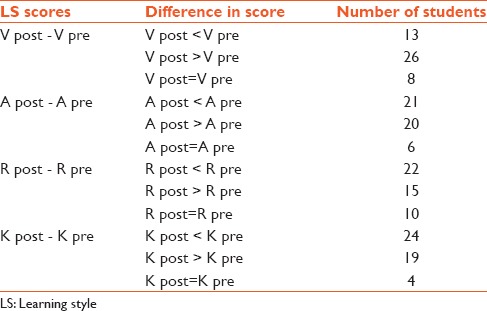
Figures 1a and b show pre- and post-intervention response of students to questions in section 2 of student questionnaire. These responses on a 4-point Likert scale showed a highly significant increase (P < 0.001) in the mean scores for all the questionnaire items in this section for assessing student awareness of LSs. At the beginning of the study, there was a lack of awareness about the concept of LSs amongst the students but after the intervention there was a significant increase in the number of students reporting that they were aware of LSs. More than three-fourth of the participants reported that they were familiar with the VARK LSPs (88%) and also familiar with the strategies available for enhancing learning (82%). Last question in this section was: According to you which type of learner you are (V/A/R/K)? In response to this question, we expected students to tick mark any one of the acronym given in the question. Few students did tick mark one of the acronyms, but it did not match with their VARK analysis result. Thus, initially no student was able to identify their own LS in accordance with the VARK preference but by the end of study 46% students could correctly identify their own LSP.
Figure 1.
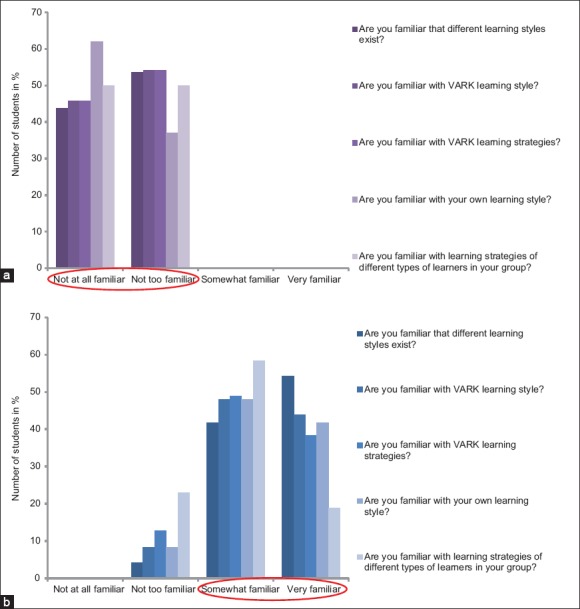
(a) Responses of the students to preintervention student questionnaire. (b) Responses of the students to postintervention student questionnaire
Table 3 shows the responses of students to questions in section 3 of the student questionnaire on a 5-point Likert scale ranging from strongly disagrees to strongly agree.
Table 3.
Mean (±SD) responses of students to questions in section 3 of the student questionnaire on a 5-point Likert scale (ranging from strongly disagree to strongly agree)
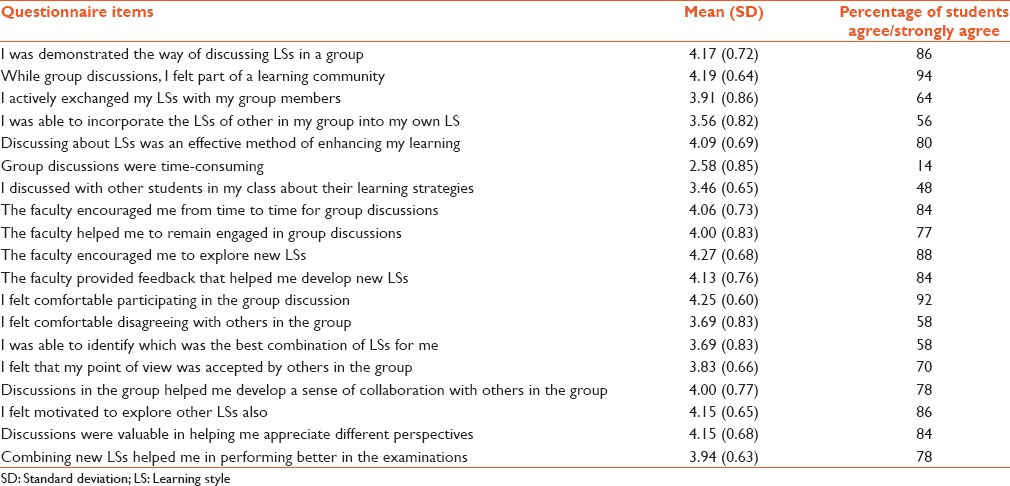
These results emphasized important points about the externally regulated strategy for enhancing learning. First, the group discussions were held in a nonthreatening environment in which all participants were encouraged to freely exchange their way of learning. They felt part of a learning community and the facilitator was successful in motivating them to try adapting to new LSs. For example, more than three-fourth of the participants agreed/strongly agreed that there was a proper demonstration of the way of discussing LSs in a group. In group discussions, they felt part of a learning community and discussions in the group helped them to develop a sense of collaboration with others in the group, discussing about LSs was an effective method of enhancing their learning and discussions were valuable in helping them to appreciate different perspectives.
The results also showed that there was adequate faculty encouragement and support to the groups and effective feedback provided by the faculty. For example, more than three-fourth of the students agreed/strongly agreed that faculty encouraged them from time to time for group discussions, helped to remain engaged in group discussions and even encouraged students to explore new LSs, felt motivated to explore other LSs, and feedback provided by faculty was helpful in developing new LSs. More than three-fourth students reported that combining new LSs helped them in improving their performance in examinations.
However, it is important to note that only 58% were actually able to identify the best combination of LSs for them. Almost a similar percentage (56%) was able to incorporate LSs of others in their group into their own LS and felt comfortable disagreeing with others in the group.
Forty-three students commented on the open-ended question in section 3 regarding challenges faced during the intervention. The major themes derived from the content analysis of this qualitative data were that applying and incorporating new LS was difficult (19/43), there was difficulty in meeting for group discussions (13/43), and it was initially difficult but later they adapted to new LSs (5/43). These themes along with the sub-themes and comments are listed in Table 4.
Table 4.
Content analysis of open-ended questions in section two of student questionnaire
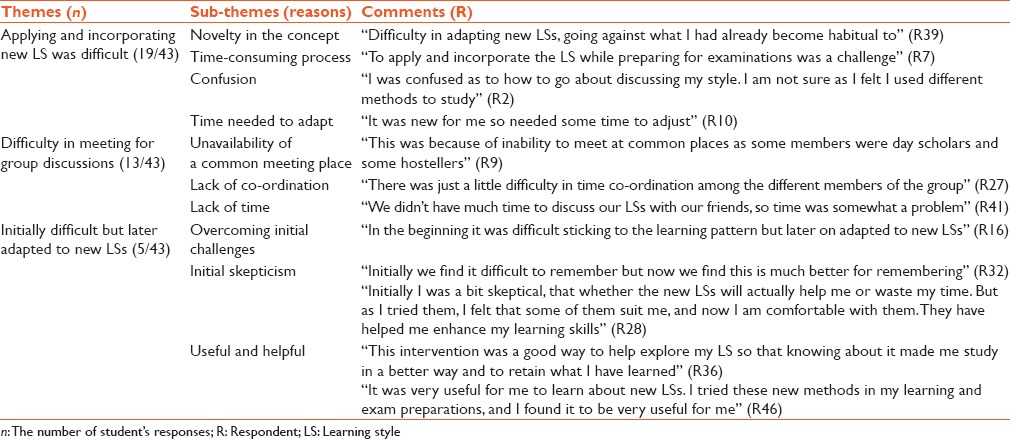
One suggestion to overcome the time constraint was “This survey should be done at school level or at the time of enrollment in medical college.” Overall students found the intervention useful and helpful. One student commented: “Knowledge of our LS helps in improving the skill. Also, group discussions helped to learn and incorporate and improve other learning methods.”
In the narratives, all six students were able to list the different LSs, identify their own LS, and describe various activities they undertook as participants. Themes regarding the strength of the intervention, barriers encountered, and recommendations along with comments of the students regarding the mixed method approach of learning are described in Tables 5 and 6. In brief, the strength of the intervention was group discussions which helped in learning. The students also developed an awareness of new LSs and more importantly the skills to incorporate it into their own style. They could also apply these learning strategies in other subjects as well. The students also became more organized.
Table 5.
Content analysis of the student narratives: Strengths and barriers encountered
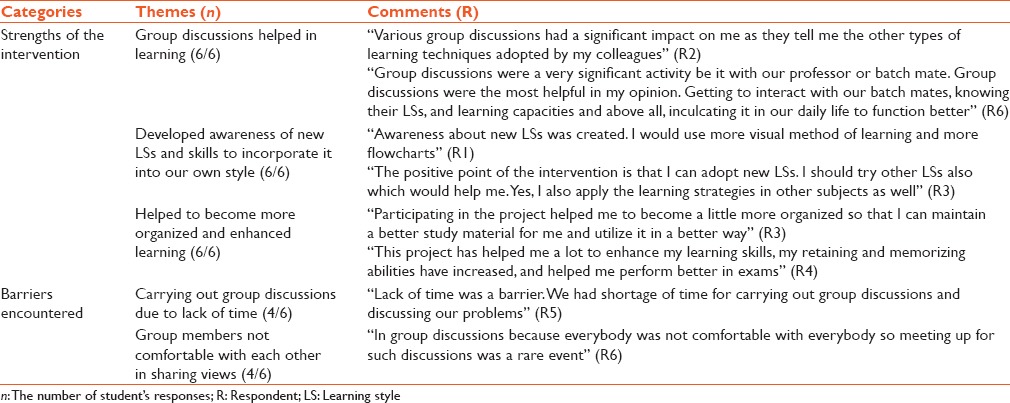
Table 6.
Recommendations for future intervention

The barriers encountered were lack of time which hindered group discussions and group members not comfortable with each other in sharing views. Despite these barriers, the students also recommended that in future all activities to be continued for a subsequent group of students, with emphasis on including more interactive sessions.
DISCUSSION
In the onion concept of LSs, an analogy has been drawn between the various concepts of LSs and the layers in an onion.[26] Thus, the three layers that is, innermost, middle, and outer represents students’ cognitive personality style, information-processing style, and instructional preference, respectively. The instruments for assessing the LSs fit into one of the three layers. The outermost layer of the LSs that is, instructional preference is the most superficial of all and also is most vulnerable to change. This justifies the use of VARK questionnaire for the present study since it is based on the sensory modality used for acquiring information and thus fits into the outermost layer that is, instructional preference.
It has recently been reported that read-write and kinesthetic learners who adopt a deep approach learning strategy perform better academically than do the auditory, visual learners who employ superficial study strategies. Previous studies have suggested that visual and auditory learners can be encouraged to adopt kinesthetic and read-write styles to enhance their performance in the examinations.[14] Thus, although there may be a predominant LS yet students can be taught to use alternative styles.
However, in available literature the process of motivating students to adapt to different LSs has not been described clearly. In the present study, more emphasis was on the process of motivating the students toward incorporating other LSs. Our first effort, therefore, was to make the students aware of various LSs and strategies they could use to enhance their learning.
After this, external regulation as a motivating factor for adopting various learning strategies was used and results of the study confirmed that the entire program for enhancing students learning was meticulously planned and well executed thereby validating the entire process. Group discussions between faculty and students were effectively conducted. The students could freely exchange their methods of learning. Student awareness of various learning strategies helped in better acceptability of external regulation for adopting various learning strategies and made it more effective.
The subsequent impact of awareness and effective external regulation was evident from student comments. A large number of students (78%) commented that use of these LSs helped them in improving their performance in the examinations even if they were not able to identify the best combination of LSs (58%) for themselves. This meant that although students could not actually figure out what was best for them yet they had already started utilizing a variety of methods for enhancing their learning. This observation was further quantitatively strengthened by pre- and post-intervention comparison of VARK scores indicating that there was a change in VARK scores of a significant number of students after the intervention. On qualitative analysis, various themes derived from the content analysis of the student interviews added further support.
Group discussions were the most important part of this external regulation strategy for enhancing learning.
Although LSs of the students were assessed using VARK questionnaire and the students were told about their preferred LSs, yet less than half the class could later on correctly recall their own VARK LS. This emphasizes the point that although initially groups were made in accordance with the LSPs of the students so as to have a heterogeneous group yet this point was not reemphasized further. This was done to facilitate students to try to incorporate other styles and not stick on to their own.
Previous research has shown that matching the teaching style to LSs of learners has some benefit.[27,28] There is also evidence that providing creative teaching/LS mismatch which required students to experience the less dominant qualities of their LSs stimulated learning.[29,30,31,32,33] Educational research suggests that optimal learning results from a certain degree of tension and disequilibrium and the learners need to be “stretched” somewhat to learn.[31,34,35]
In summary, this study outlines a well-planned roadmap of appropriate use of externally regulated learning strategy, wherein on the background of prior knowledge of various LSs and strategies, students were encouraged to incorporate a combination of learning strategies which best suits them.
Since this study was carried out at the time when students were nearing the completion of their 1st year in medical college and were very close to taking the final examination, paucity of time needed for self-directed efforts at incorporating newer LS strategies was an important limitation. This could be overcome by undertaking these efforts at the time of enrollment of students in medical college so that students have sufficient time at hand to try out the novel techniques.
Another limitation of the study was that we did not specifically measure the level of Blooms taxonomy/Miller's pyramid, this intervention tried to address.
Further research in sufficiently sensitized students toward the use of the mixed method approach for learning, can be planned to find out which domain of learning and which level of Blooms taxonomy/Miller's pyramid has been enhanced.
CONCLUSION
Awareness of individual LSs among 1st year MBBS students and the use of an externally regulated strategy for enhancing learning helped students adapt to other LSs. This enhanced the use of better learning practices and, therefore, better learning outcomes. Thus, knowledge of VARK LSP of the student should not be considered as a restriction to use that particular style only. Rather, teachers should make a conscious effort to let the students explore other LSs as well.
Acknowledgments
I acknowledge all the students who participated in the study, my head of department who allowed me all the time I needed for conducting this study and all learned FAIMER Faculty whose constructive criticism was helpful in giving this study the present shape.
Financial support and sponsorship
Nil.
Conflicts of interest
There are no conflicts of interest.
REFERENCES
- 1.Keefe JW. Reston, VA: National Association of Secondary School Principals; 1987. Learning Style: Theory and Practice. [Google Scholar]
- 2.Bruner JS. Cambridge: Harvard University Press; 1967. Towards a Theory of Instruction. [Google Scholar]
- 3.Norman G. When will learning style go out of style? Adv Health Sci Educ Theory Pract. 2009;14:1–4. doi: 10.1007/s10459-009-9155-5. [DOI] [PubMed] [Google Scholar]
- 4.Cassidy S. Learning styles: An overview of theories, models, and measures. Educ Psychol. 2004;24:419–44. [Google Scholar]
- 5.Coffield F, Moseley D, Hall E, Ecclestone K. Should we be using learning styles? What research has to say to practice? Learning and Skills Research Centre. 2004. [Last accessed on 2014 Dec 16]. Available from: http://www.LSRC.ac.uk /2014/December/.pdf .
- 6.Fleming ND, Mills C. Not another inventory, rather a catalyst for reflection. Improve Acad. 1992;11:137–155. [Google Scholar]
- 7.Fleming ND. VARK: A Guide to Learning Styles. [Last accessed on 2009 Mar 03]. Available from: http://www.vark-learn.com/english .
- 8.Vermetten YJ, Vermunt JD, Lodewijks HG. A longitudinal perspective on learning strategies in higher education: Different viewpoints towards development. Br J Educ Psychol. 1999;69:221–42. [Google Scholar]
- 9.Vermunt JD, Verloop N. Congruence and friction between learning and teaching. Learn Instr. 1999;9:257–80. [Google Scholar]
- 10.Baykan Z, Naçar M. Learning styles of first-year medical students attending Erciyes University in Kayseri, Turkey. Adv Physiol Educ. 2007;31:158–60. doi: 10.1152/advan.00043.2006. [DOI] [PubMed] [Google Scholar]
- 11.Breckler J, Joun D, Ngo H. Learning styles of physiology students interested in the health professions. Adv Physiol Educ. 2009;33:30–6. doi: 10.1152/advan.90118.2008. [DOI] [PubMed] [Google Scholar]
- 12.Hughes JM, Fallis DW, Peel `JL, Murchison DF. Learning styles of orthodontic residents. J Dent Educ. 2009;73:319–27. [PubMed] [Google Scholar]
- 13.Dobson JL. Learning style preferences and course performance in an undergraduate physiology class. Adv Physiol Educ. 2009;33:308–14. doi: 10.1152/advan.00048.2009. [DOI] [PubMed] [Google Scholar]
- 14.Kumar LR, Voralu K, Pani SP, Sethuraman KR. Association of kinesthetic and read-write learner with deep approach learning and academic achievement. Can Med Educ J. 2011;2:e23–7. [Google Scholar]
- 15.Latha RK, Voralu K, Pani SP, Sethuraman KR. Predominant learning styles adopted by the AIMST university students in Malaysia. South East Asian J Med Educ. 2009;3:37–46. [Google Scholar]
- 16.Cook DA, Thompson WG, Thomas KG, Thomas MR. Lack of interaction between sensing-intuitive learning styles and problem-first versus information-first instruction: A randomized crossover trial. Adv Health Sci Educ Theory Pract. 2009;14:79–90. doi: 10.1007/s10459-007-9089-8. [DOI] [PubMed] [Google Scholar]
- 17.Furnham A, Jackson CJ, Miller T. Personality, learning style and work performance. Pers Individ Dif. 1999;27:1113–22. [Google Scholar]
- 18.Hattie J, Biggs J, Purdie N. Effects of learning skills interventions on student learning. Rev Educ Res. 1996;66:99–136. [Google Scholar]
- 19.Vaughn L, Baker R. Teaching in the medical setting: Balancing teaching styles, learning styles and teaching methods. Med Teach. 2001;23:610–2. doi: 10.1080/01421590120091000. [DOI] [PubMed] [Google Scholar]
- 20.Kumar LR, Chacko TV. Using appreciative inquiry on learning styles to facilitate student learning. Med Educ. 2010;44:1121–2. doi: 10.1111/j.1365-2923.2010.03842.x. [DOI] [PubMed] [Google Scholar]
- 21.Kirby JR. Style, strategy and skill in reading. In: Schmeck RR, editor. Learning Stratad Learning Styles. New York: Plenum Press; 1988. pp. 229–74. [Google Scholar]
- 22.Pask G. Learning strategies, teaching strategies and conceptual learning style. In: Schmeck RR, editor. Learning Strategies and Learning Styles. New York: Plenum Press; 1988. pp. 83–100. [Google Scholar]
- 23.Leite WL, Svinicki M, Shi Y. Attempted validation of the scores of the VARK: Learning styles inventory with multitrait-multimethod confirmatory factor analysis models. Educ Psychol Meas. 2010;70:323–39. [Google Scholar]
- 24.Downing SM. Validity: On meaningful interpretation of assessment data. Med Educ. 2003;37:830–7. doi: 10.1046/j.1365-2923.2003.01594.x. [DOI] [PubMed] [Google Scholar]
- 25.Vyas R, Tharion E, Sathishkumar S. Improving the effectiveness of physiology record books as a learning tool for first-year medical students in India. Adv Physiol Educ. 2009;33:329–34. doi: 10.1152/advan.00050.2009. [DOI] [PubMed] [Google Scholar]
- 26.Curry L. Ottawa: Canadian Medical Association; 1981. Learning Style in Continuing Medical Education. [PMC free article] [PubMed] [Google Scholar]
- 27.Highfield ME. Learning styles. Nurse Educ. 1988;13:30–2. doi: 10.1097/00006223-198811000-00015. [DOI] [PubMed] [Google Scholar]
- 28.Rezler AG, Rezmovic V. The learning preference inventory. J Allied Health. 1981;10:28–34. [PubMed] [Google Scholar]
- 29.Baker JD, 3rd, Cooke JE, Conroy JM, Bromley HR, Hollon MF, Alpert CC. Beyond career choice: The role of learning style analysis in residency training. Med Educ. 1988;22:527–32. doi: 10.1111/j.1365-2923.1988.tb00798.x. [DOI] [PubMed] [Google Scholar]
- 30.Cavanagh SJ, Coffin DA. Matching instructional preference and teaching styles: A review of the literature. Nurse Educ Today. 1994;14:106–10. doi: 10.1016/0260-6917(94)90112-0. [DOI] [PubMed] [Google Scholar]
- 31.Grasha A. Nova Scotia: Halifax; 1981. Learning style: The journey from Greenwich Observatory (1796) to Dalhousie University. [Google Scholar]
- 32.Kosower E, Berman N. Comparison of pediatric resident and faculty learning styles: Implications for medical education. Am J Med Sci. 1996;312:214–8. doi: 10.1097/00000441-199611000-00004. [DOI] [PubMed] [Google Scholar]
- 33.Partridge R. Learning styles: A review of selected models. J Nurs Educ. 1983;22:243–8. doi: 10.3928/0148-4834-19830601-06. [DOI] [PubMed] [Google Scholar]
- 34.Dember W. The new look in motivation. Am Sci. 1965;53:409–27. [Google Scholar]
- 35.Grasha A. Observations on relating teaching goals to student response styles and classroom methods. Am Psychol. 1972;27:144–7. [Google Scholar]


